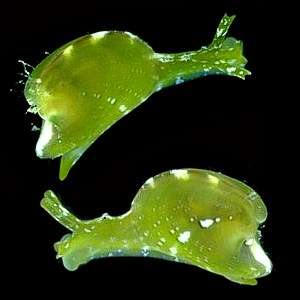
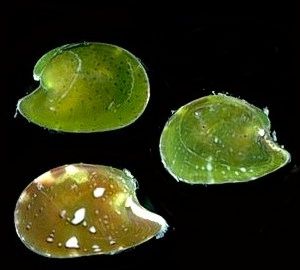
Julia exquisita
(Gould, 1862)
Order: SACOGLOSSA
Superfamily: OXYNOOIDEA
Family: Juliidae
DISTRIBUTION
This easily recognised bivalved sacoglossan is widespread throughout the Indo-West Pacific.
PHOTO
UPPER: Living animals showing typical sacoglossan head and tentacles. LOWER: Differently coloured shells of three animals. Animal approximately 5mm long alive. Koumac, New Caledonia, October 1993. PHOTOS: Bill Rudman.
Julia exquisita is one of a group of remarkable sacoglossan 'snails' which have a bivalve shell. Known only from their fossil shells until a few years ago, they were usually considered to be bivalves rather than gastropods. It is thought that the bivalved shell evolved from a lightly calcified shell like that of Oxynoe or Lobiger.
The shell is more heavily calcified than the species of the Berthellininae and varies in colour from bright green to reddish brown. A pattern of radiating spots can be present on the shell and can consist of white spots or darker shades of the background colour. There are a number of species of Julia with slight differences in the shape and colour of the shell.
See Cory Pittman's message below which discusses four species from Hawaii. See separate messages for details of Hawaiian records and the shell.
References:
• Gould, A.A. (1862) Descriptions of new genera and species of shells. Boston Society of Natural History, Proceedings, 8: 280-285.
• Kay, E.A. (1962) Julia exquisita Gould, a bivalved gastropod. Pacific Science, 16(4): 434-435.
Rudman, W.B., 2001 (October 4) Julia exquisita (Gould, 1862). [In] Sea Slug Forum. Australian Museum, Sydney. Available from http://www.seaslugforum.net/find/juliexqu
Related messages
Julia exquisita found in my tank
August 14, 2006
From: Andy Jukes
Hi there i seem to have some Julia exquisita in my tank. I use to grow Caulerpa to feed my main display tank ! they are really fantastic to watch and i was wondering if there was anything i can do to make sure they have a good life in there! do they require and special care?
Andy Jukes
London
andrewjukes@blueyonder.co.uk
Jukes, A., 2006 (Aug 14) Julia exquisita found in my tank. [Message in] Sea Slug Forum. Australian Museum, Sydney. Available from http://www.seaslugforum.net/find/17413Dear Andy,
I know it may not be possible for you, but it would be nice to see a photo of your animals. Without one I can't really be sure you have Julia. I am pretty sure the Caulerpa is a very important part of the equation. This group of sea slugs feed on species of Caulerpa, so I guess the Caulerpa, or one of the species you had in your holding tank, was the one they preferred.
Best wishes,
Bill Rudman
The bivalved sacoglossan genus Julia in Hawaii
October 12, 2001
From: Cory Pittman
Dear Bill,
The Juliids are one of my favorite groups and, for many years, I've been observing them in Hawaii. Although the rest of the shells in your photo are clearly Julia exquisita, the upper right photo is actually Julia zebra. In my opinion, based on consistent differences not only in their color but also in their shell morphology, these species are not synonyms. In addition, I believe there are two other valid species of Julia in Hawaii. All four appear to have broad Indo-Pacific distributions. I'm including photos and information on all of them in separate messages. Image sizes in each of the three sets of shell photos were adjusted to the same standard in order to emphasize the proportional differences in shell morphology. I hope this will be of interest.
See separate messages for:
Julia exquisita
Julia zebra
Julia sp. 1
Julia sp. 2
Best wishes,
Cory
cory@cet.com
Pittman, C., 2001 (Oct 12) The bivalved sacoglossan genus Julia in Hawaii. [Message in] Sea Slug Forum. Australian Museum, Sydney. Available from http://www.seaslugforum.net/find/5371Dear Cory,
Thanks for all the interesting information on Hawaiian species of Julia that you have sent today in separate messages. I will have to check through my notes and photos to see what I have really found in the past. I must say that I thought I could see a clear gradation from one colour type to another and so assumed I was dealing with a single species. It would be interesting to know whether these species have different food requirements.
You have given me the impetus to look out my photos on the temperate southeastern Australian bivalved sacoglossans to add to the Forum. They certainly seem to prefer different species of Caulerpa
Thanks again,
Bill Rudman
Hawaiian Julia exquisita
October 12, 2001
From: Cory Pittman
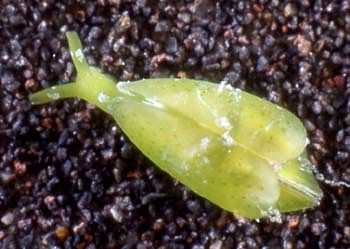
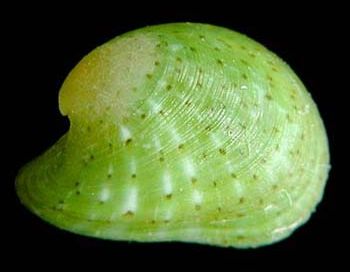
On Maui, Hawaiian Ids, shells of Julia exquisita (Gould, 1862) are common in sand samples that include material from shallow, moderately exposed to exposed, rocky habitats. All told, I've seen several thousand valves with a maximum shell length of 5.2 mm. I've also picked up 12 live animals in algae washes from depths of less than 1 m to 3 m. The background color ranges from green to straw and the exterior is marked by radiating rows of brown or dark green spots, each with a cloudy white "halo" extending dorsally. The size of the spots and number of rows is highly variable but the general pattern is consistent. Rarely, shells may lack spots completely. In living animals, the body is green with scattered white flecks. The hinge is large and the central, tooth-like knob is oval in cross section with a "bean-shaped" apex.
Julia japonicum Kuroda & Habe, 1951 is apparently closely related based on photos and shells that Terry Gosliner showed me when I visited the California Academy of Sciences.
I've found shells in sand samples (sent to me by Pauline Fiene-Severns and Jerry Flora) from Midway Atoll, Raratonga and Magaia(Cook Islands).
The live shot is of a 3.5 mm animal collected in an algae wash at Hekili Point, Maui on October 14, 1997. It was at a depth of less than 1 m. The shell photos [see separate message] are of a hinged pair, 4.5 mm in length. It was in a "random bottle" rather than one of my quantitative samples but was probably found in beach drift at Maalaea Bay, Maui.
Cory Pittman
cory@cet.com
Pittman, C., 2001 (Oct 12) Hawaiian Julia exquisita. [Message in] Sea Slug Forum. Australian Museum, Sydney. Available from http://www.seaslugforum.net/find/5372Shell of Julia exquisita
October 12, 2001
From: Cory Pittman
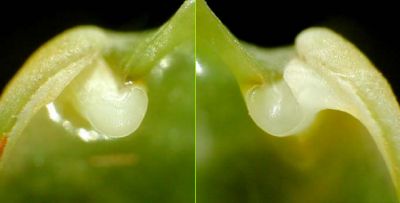
Here are detailed shell photos of Julia exquisita from Hawaii to accompany my earlier message. All told, I've seen several thousand valves with a maximum shell length of 5.2 mm. The background color ranges from green to straw and the exterior is marked by radiating rows of brown or dark green spots, each with a cloudy white "halo" extending dorsally. The size of the spots and number of rows is highly variable but the general pattern is consistent. Rarely, shells may lack spots completely. The hinge is large and the central, tooth-like knob is oval in cross section with a "bean-shaped" apex.
The shell photos are of a hinged pair, 4.5 mm in length. It was in a "random bottle" rather than one of my quantitative samples but was probably found in beach drift at Maalaea Bay, Maui.
Cory Pittman
cory@cet.com
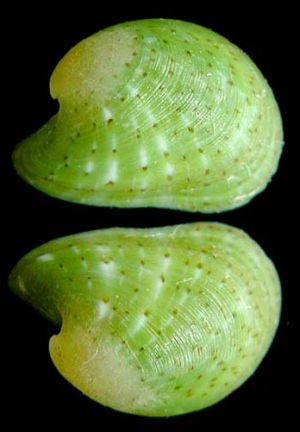
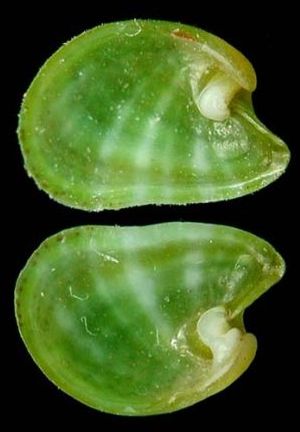
The bivalved sacoglossan Julia exquisita
July 21, 1999
From: Bill Rudman

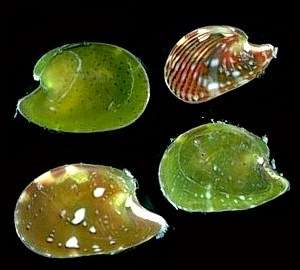
I have posted a page on Julia exquisita, a typical species of the Juliidae, in answer to Grey McNeil's recent enquiry.
PHOTOS: UPPER: Living animals showing typical sacoglossan head and tentacles. LOWER: Differently coloured shells of four animals. Animal approximately 5mm long alive. Koumac, New Caledonia, October 1993. PHOTOS: Bill Rudman.
Julia exquisita is one of a group of remarkable sacoglossan 'snails' which have a bivalve shell. Known only from their fossil shells until a few years ago, they were usually considered to be bivalves rather than gastropods. It is thought that the bivalved shell evolved from a lightly calcified shell like that of Oxynoe or Lobiger.
The shell is more heavily calcified than the species of the Berthellininae and varies in colour from bright green to reddish brown. A pattern of radiating spots and lines can be present on the shell and can consist of white spots or darker shades of the background colour. It is probable the other species of Julia that have been described are colour forms of this species.
Bill Rudman.
